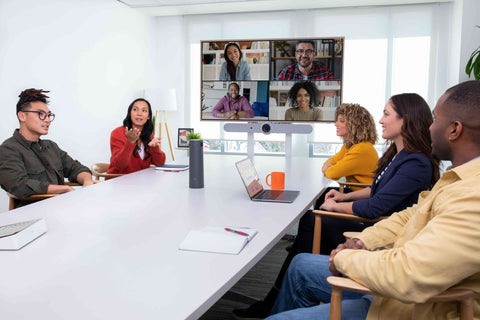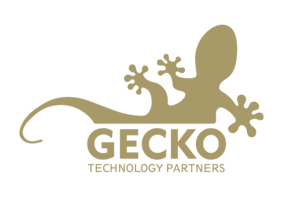Presenting yourself clearly and confidently in meetings is essential for effective communication and building strong connections. However, joining a call from a poorly-designed meeting room can often pose challenges that impact your ability to participate fully and show up in the way you want to be seen. Bad camera framing, insufficient lighting, inadequate microphone coverage and distracting background sounds are all common challenges in a meeting room environment that can cause disruptions and make it difficult for participants to engage with you.
Fortunately, you can overcome these challenges with thoughtful room design, the right Google Meet Hardware and a variety of Google Meet features. Whether you’re setting up a new meeting space or simply looking to improve your existing setup, we explore practical tips and tools to help you create a professional and engaging environment for looking and sounding your best in every call.
Specifically, we share tips about how to:
- Optimise your meeting space
- Maximise the device-based features on your Google Meet Hardware
- Utilise software-based features on your Google Meet Hardware
Looking and sounding your best in a Google Meet call on web and mobile is equally important for making a great first impression, feeling confident and building meaningful relationships. As part of our “Bringing your best self to Google Meet” series, we share valuable tips, tricks and features on this topic across this and two more blog posts. The first blog post focuses on features for looking your best, including virtual backgrounds and camera framing, whilst the second highlights features for sounding your best, such as noise cancellation and adaptive audio. You can read them both here:
Optimising your meeting space

A well-designed meeting room is essential for looking and sounding your best in Google Meet and making a positive impression. Google's Room Design Guide provides a comprehensive toolkit for beginning to create a professional conferencing space that is fit for purpose. From hardware and layout recommendations to tips for improving lighting, acoustics, privacy and more, the guide helps you consider each aspect of the room that can play a role in shaping the best possible meeting experience.
Key tips from the guide include:
- How to avoid acoustic problems, such as echoes, muffled audio and background noise, to ensure clear, high-quality sound within the space. This includes using acoustic treatments on walls, floors and ceilings, taking advantage of unusually shaped rooms and avoiding placing screens in neighbouring rooms on back-to-back walls.
- Ways to decorate and light a space to ensure everyone in the room can see, and be seen by, on-screen participants clearly. This includes using tables with light surfaces to illuminate faces and adding blinds or curtains to external and internal windows to prevent glare and maintain privacy.
- How and where to place peripherals to ensure everyone in the room can be seen, heard and represented equally. This considers factors such as the camera height and mounting position as well as the spacing between mic pods.
If your team is setting up a new room, the room designer tool in the guide enables you to visualise what your space could look like based on the number of participants. Simply enter the room size (i.e. how many participants the room can accommodate) and the tool will show different layouts and how Google Meet Hardware can fit into them. It also provides recommendations for things like screen size and table size along with optional hardware add-ons such as a dual-screen setup, Board 65 or Logitech Scribe.
Device-based features
Looking your best
Depending on your Google Meet Hardware kit, you can utilise a range of device-based camera framing modes during a meeting to help you and your team look your best. If your kit supports device-based framing, you’ll see a “Framing by” toggle on the meeting room’s touch controller followed by the name of the provider handling the framing, for instance “Framing by Logitech”, “Framing by Huddly” or “Framing by Poly”.
Different providers’ framing modes can differ and some have multiple options. For instance, “Framing by Logitech” will activate the framing mode chosen in Logitech Sync – which, on the Rally Bar family of devices, could be Speaker View (camera tracks the speaker), Group View (camera frames all participants in the room with minimal excess empty space) or Grid View (camera shows individual shots of up to four room participants in a tiled layout).
Meanwhile, the Poly Studio X family of meeting room devices has a feature called DirectorAI that allows you to define the area within which your conferencing system will track and frame participants. This is particularly useful in meeting rooms with glass walls where the camera might otherwise capture what’s happening outside of the room. By setting a perimeter, you can ensure the camera focuses solely on in-room participants, eliminating distractions and keeping the meeting on track.

To increase meeting equity and ensure everyone around the table feels seen, Logitech Sight can be a great addition to enhance your spaces. Sight is a tabletop camera that works together with the Rally Bar or Rally Bar Mini to provide a consistent, front-facing view of in-room participants, even as they shift their body position to engage with people on the screen and around the table.
For larger, more complex spaces equipped with bespoke solutions like Q-SYS for Google Meet, you can install multiple cameras around the room and configure the system to automatically switch to the camera that best keeps the active speaker in focus. This ensures remote participants can always see who's speaking, making the meeting more engaging and inclusive.
Sounding your best

It’s equally important that everyone around the table is heard clearly in addition to being seen clearly. If you have a larger space, consider adding more microphones to your room to expand audio coverage. Depending on your Google Meet Hardware kit, you can use the Logitech Rally Mic Pod, Logitech MeetUp Expansion Microphone or the Series One Mic Pod.
To limit distractions during a meeting and ensure remote participants are focusing on you, the entire Series One device lineup – including collaboration devices Board 65 and Desk 27 – has built-in TrueVoice noise cancellation technology. TrueVoice filters out unwanted background sounds whilst amplifying human voices to make conversations sound their very best.
Software-based features
Looking your best
In addition to device-based camera framing, all Google Meet Hardware devices offer software-based camera framing to keep everyone in shot. The “Frame people” setting initiates a one-time adjustment of the camera view. It zooms in when fewer people are in a large room or provides a wider shot if more people are joining. This reduces empty space and allows remote participants to see more of people’s facial expressions, gestures and body language – pivotal for effective communication.
💡 To save teams having to readjust the camera per device and per call, admins can set a default camera framing option for each meeting room device from the Google Admin panel. This can be done either individually for each device or in bulk.
When using a Desk 27 or Chromebase for meetings 2, try enabling the automatic lighting adjustment feature to make sure you can be clearly seen during the call. (Google has plans to add automatic lighting adjustment to a wider array of Google Meet Hardware in future.) With this feature, Meet can detect and adjust underexposed video feeds to enhance your appearance and minimise any distractions caused by poor video quality.

If you’re joining a meeting on a second device, such as a laptop or mobile phone, through Google Meet companion mode there are two features in particular that you can leverage to help you look your best. Firstly, consider sharing your video feed from your device’s camera to give remote participants a clearer view of you and your facial expressions. Secondly, check in to the meeting room that you’re in so everyone can recognise you by your name instead of the name of the room. Combined, these features will help remote participants better acknowledge your presence and build stronger connections with you.
💡 Want to learn more about Google Meet companion mode and how it makes hybrid meetings more inclusive? Take a look at our comprehensive guide.
Sounding your best
Software-based noise cancellation is available on all Google Meet Hardware devices and can be used to eliminate any distracting background noise such as keyboard typing, phone vibrations and crinkling snack packaging. You can enable it before or during a meeting to make sure remote participants can easily focus on you and the other people in the room.
💡 If your team's meetings often involve non-speech audio, such as playing musical 🎺 instruments, Google recommends turning off noise cancellation. This ensures that these sounds are captured and transmitted clearly during your video calls.
Discover Tips on Looking and Sounding Your Best in Google Meet on Web and Mobile
Joining a Google Meet call from your laptop, desk or mobile device and want to ensure you look and sound your best there too? We’ve got you covered! Whether you’re dealing with poor lighting conditions or distracting audio feedback, we’ve got two comprehensive resources for both.
Discover more in our “Bringing your best self to Google Meet” series:
